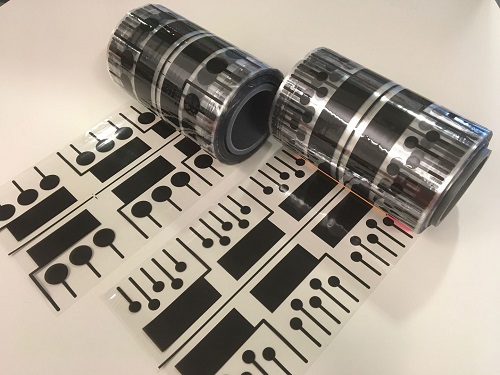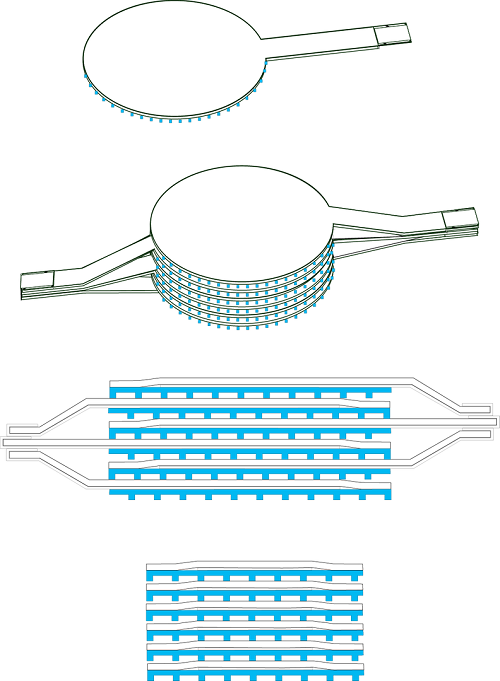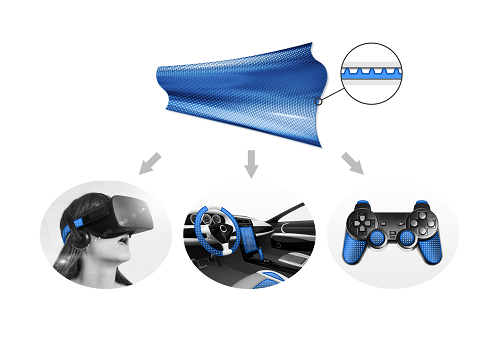By Gina Roos, editor-in-chief
Creating a new category of flexible electronics, Senseg has unveiled the industry’s first family of flexible actuators, manufactured on newly developed roll-to-roll manufacturing technologies, delivering advantages in scalability, size, weight, and cost. The new Senseg elastomeric film actuator, or ELFIAC, can be used as a replacement for traditional actuators, including piezoelectric devices. It also opens up new opportunities for haptic technologies in applications, such as wearables, soft robotics, and virtual reality/augmented reality (VR/AR) devices.
The flexible actuator is composed of insulated electrode films separated by silicone elastomer spacers, or pillars. The silicon micro pillars work like springs. An electrostatic force compresses the layers and provides the actuation. The key enablers are the mechanical properties of the liquid silicon rubber used in the elastomer pillars, micromachining technologies, new manufacturing methods for flexible electronics, which enables scaling as well as very large sizes, and a new high-voltage driver.

A prototype of the Senseg ELFIAC printed roll. (Image: Senseg)
Traditional actuators like eccentric rotating mass (ERM) motors, linear resonant actuators (LRAs), and piezoelectric (piezo) actuators are used as haptic interfaces, delivering tactile feedback in applications such as mobile phones, tablets and other consumer devices. However, haptic technologies have faced several challenges, including size, cost, and power consumption.
The Senseg actuator was developed to address these challenges. The scalable ELFIAC technology has been proven for mass production, and is said to be less expensive to produce than comparable traditional actuators, like piezos. In addition to lower cost manufacturing, the ELFIAC offers several additional benefits, including the use of lower cost, non-toxic materials, and the capability to be produced in any number of form factors and geometries.
The ELFIAC is the first roll-to-roll printed actuator technology, said Ville Mäkinen, founder and general manager of Senseg. The key enabler is the newly developed technologies that allows for printing with silicon structures [silicon micro pillars], which brings cost benefits that are unparalleled, especially when compared with piezoelectric actuators, he said.
Mäkinen said the flexible actuators are priced at a fraction of the cost of a piezoelectric actuator. A large piezo costs between $20 to $50, while a similar flexible actuator is almost at a disposable price level because it only consists of film materials, he said. Of course, there is the driver unit, but Mäkinen said it is very cost competitive, and a single driver can drive multiple actuators, which is where the cost benefit is really noticeable.
Furthermore, it doesn’t contain lead like piezos; it can be readily adapted to consumer electronics products, and it can print different shapes, which allows for customization, Mäkinen continued. In addition, changing the patterns on the rolls are no more complicated than it is to print a different newspaper on a printing machine, he added.
The ELFIAC can be made into different shapes and sizes thanks to the actuator layers that can be stacked into multiple layers, depending on the application. The thickness of the stack can range from fractions of a millimeter to several millimeters. The actuation displacement is up to 20% of the overall stack.

The flexible actuator is composed of insulated electrode films separated by silicone elastomer spacers, or pillars. (Image: Senseg)
Another benefit is a wide operating temperature range, thanks to the liquid silicon technology. The operating temperature range is -40°C to 100°C. The company also offers versions that can withstand higher temperatures. Senseg pegs the operating life at “hundreds of millions of operating cycles.”
Key features include:
- Excellent low-frequency performance, and high actuation displacement, up to 20% of stack thickness
- Lead-free and biocompatible
- Can perform pressure sensing
- Sizes from below 1 cm2 to very large, and thicknesses from 0.1 mm to very thick
- Operating voltage starts at a couple of hundred volts
- Flexible, bendable, and can be manufactured in any shape, flat or curved, or size
One of the biggest design challenges of haptic technologies is power consumption. Senseg also introduced a new low-power, high-voltage driver circuit for the ELFIAC, specifically designed for consumer applications. The driver IC is comprised of a proprietary system-in-package (SiP) S220 chip, jointly developed with STMicroelectronics. The chip uses flyback topology to generate a high voltage even from a single-cell 3.7-volt battery.
New applications
The thin polymer films used in the new actuators are very flexible, which makes them suitable for applications like clothing, VR/AR gloves, and other apparel. It also can be made into any size or shape — flat or curved — so it also can be used to actuate large surfaces like industrial control panels, flight or automotive controls, and meeting room screens.
“Haptics is very much about conforming to the human shape, so it can be integrated into a number of things, including a chair or car seat,” said Mäkinen.
The actuator market is forecast to reach $75 billion by 2025, from a market size of about $50 billion in 2019, according to a MarketsandMarkets report. Applications include consumer, automotive, healthcare, industrial automation, hydraulic, and other market segments. Since the ELFIAC technology can be manufactured in almost any shape or size, it can be used in any of these markets, although Senseg said the most cost-effective applications are larger than mobile devices.
Michael Inouye, principal analyst, ABI Research, who covers VR/AR technologies, told Electronic Products that there has been some early haptics activity in the VR market, although it’s been limited in terms of deployments or traction in the wider market.
“Most solutions come in the form of gloves or other wearables (e.g. finger devices, footwear, or bodysuits) and range in sophistication from vibration type feedback (similar to rumble packs in game controllers) to resistive force feedback like HaptX,” said Inouye. “Senseg’s technology more closely parallels what we’ve seen in some of the finger-type devices, but promises to scale better and bring costs down, which would certainly help bring these devices closer to the VR mainstream.”
“Other companies in the space are looking at gloves and other haptics as one of the next evolutionary steps for VR; not only in gloves and other wearables, but also on the head-mounted displays (HMDs) — e.g. the touch panels on the side of the HMD,” he added. “With regards to the HMDs this could also benefit AR smart glasses as well, where the haptics can be used to help users identify and interact with UI controls.”

ELFIAC is comprised of thin polymer films that make it higher flexible and compliant to fit a range of applications. (Image: Senseg)
Inouye also believes that the Senseg technology could make the user experience more immersive. “If it helps jumpstart the use of new wearables like gloves, it could certainly engender new use cases that can take advantage of the enhanced levels of user input and controls afforded by full hand/finger tracking.”
He also noted that it could bring additional levels of precision such as to training applications. “In some ways, these haptics and wearables can bring in some of the extra sensory stimuli that help make the experiences more deeply immersive — we’ve seen this from some location-based VR installations that are using physical props and environmental effects to enhance the user experience. Haptics could bring some of this at a smaller scale to more users.”
For designers, one of the key benefits will be familiarity, added Inouye. He explains: “Senseg’s technology doesn’t radically change how the haptics are experienced by the end user, so companies should be able to make the switch to Senseg’s solution if it does in fact prove to scale better and offer lower costs — with the added benefit/flexibility of working with a range of applications from finger devices and gloves to full bodysuits and HMDs.”
Inouye expects Senseg’s technology will be used in other markets first (e.g. smartphones/mobile and automotive) before transitioning to VR/AR applications. “Presuming there is good success here. Satisfying the smartphone market would certainly be proof-positive it can scale for cost-effective mass production, so it should be a natural transition to AR/VR. This includes both HMDs and smartphones. For example, haptic feedback on the smartphone could be used to provide textures to virtual objects displayed on the smartphone in an AR application.”
Haptic technologies are all about improving the user’s experience, particularly in consumer devices. But Senseg expects the membrane-like structure of the ELFIAC technology will take haptics to a new level beyond the initial scope of consumer electronics products.
Demo kits with plug-and-play hardware are available for designers to test drive the ELFIAC and driver IC. The kit includes ELFIAC actuators, high-voltage drivers, a hard-shelled carry case, and a USB memory stick with the control application, user instructions, example signal waveforms, and other documentation.
The article originally published on EE Times , sister publication of Electronic Products.
Advertisement
Learn more about Electronic Products Magazine





